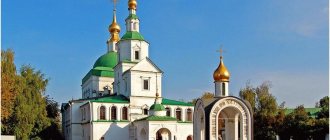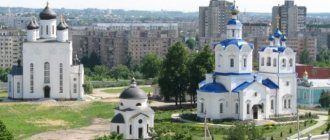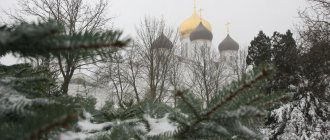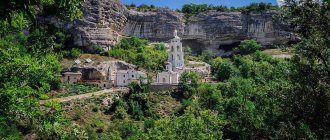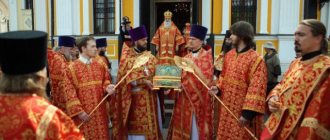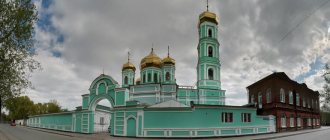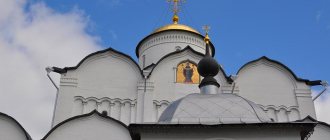The official name is the Holy Ascension Monastery “Bancheny” of the Chernivtsi-Bukovina diocese of the Ukrainian Orthodox Church
| Banchensky Holy Ascension Monastery | |
| Gender of inhabitants | male |
| Control | diocesan |
| Official site | bancheny-mon.church.ua |
| Address | With. Bancheny, Gertsaevsky district. Chernivtsi region, 60523 |
| Phones | +38(03740)2-11-50 +38(03740)3-33-19 — orphanage +38(03740)2-21-78 — pilgrim’s house |
| Monastery opening date | 06.12.1996 |
| Hegumen (abbot of the monastery) | Archbishop Longinus (Zhar) |
| Languages in which services take place | Church Slavonic, Romanian |
Banchensky Holy Ascension Monastery is a male monastery of the Chernivtsi-Bukovina diocese of the Ukrainian Orthodox Church.
The Banchen Monastery is located between the village of Banchen and the town of Hertsa. The land on which the temple is located is famous for its pristine forests and thick fogs at the foot of the mountains close to the monastery.
Banchensky Holy Ascension Monastery
The largest non-Slavic monastery in the Russian Church
Vicar of the Chernivtsi diocese, Bishop Meletiy of Khotyn writes about the Banchensky Holy Ascension Monastery:
“This is a completely unique part of our country and the Church. The locals live their own way of life, in the Romanian tradition.
There are still people in the villages who do not understand the Ukrainian language, although the region has been in Ukraine for 70 years.
In churches, services are officially celebrated in the new style and in Romanian.
There is a special blessing for this from His Holiness Patriarch Alexy I.
The fact is that the Romanian Church is new-calendar, therefore, when the Hertsaevsky district became the canonical territory of the Moscow Patriarchate, in order to prevent possible schisms, the parishes retained the right to serve as they were accustomed to.
But in the Banchen Monastery, probably the largest non-Slavic monastery in the Russian Church, they also serve in Romanian, but still according to the old style.”
Meletius
bishop
Complex of Banchensky Holy Ascension Monastery
In 1994 - 1998, the Church of the Ascension was built on the territory of the monastery; in 1995, construction began on the Church of the Intercession with the lower chapel of St. Seraphim of Sarov and the underground chapel of St. Sergius of Radonezh. Now the monastery complex includes:
1998
this year the Ascension Church was built
- two fraternal corps;
- two hotels for pilgrims;
- the abbot's house with the brethren's cells;
- monastery;
- Transfiguration Church;
- Chapel of the Nativity;
- the Church of St. Lazarus the Four-Days at the cemetery;
- bell tower with body;
- Holy Trinity Cathedral;
- Church of the Ascension of the Lord;
- Church of the Intercession of the Blessed Virgin Mary;
- underground temple of St. Sergius of Radonezh;
- healing source;
- orphanage - shelter.
Complex of the Holy Ascension Monastery in Bancheny
Description[edit]
The orphanage operates under the tutelage of the monastery (60512, Molnitsa village, Gertsaevsky district, Chernivtsi region). In 1997-2002 it was located in the abbot's house. In 1999, Christians from. Molnitsy donated a plot of land for the construction of a new building for the Children's Home, which began the same year. In 2001, a temple was founded on the site in honor of the icon of the Mother of God “Joy of All Who Sorrow,” and in 2002 the consecration of the church and the 1st building of the Orphanage took place. Now the Orphanage is a large complex of buildings. As of 2012, 400 children live here, incl. more than 80 congenital disabled people and more than 80 HIV-infected people. Their guardianship meets all medical standards and the norms of the current legislation on social protection. Child care is provided by the nuns of the Boyana Monastery.
Shrines of the Banchensky Holy Ascension Monastery
Every year, pilgrims from all over the world come to the Holy Ascension Monastery in Bancheny.
The monastery on the border with Romania is famous for its shrines throughout the world.
The most famous shrines are particles of the Relics of the Holy Innocent Innocents of Bethlehem and Lavra Saints, particles of the Life-Giving Tree of the Cross of Christ from Jerusalem, the holy relics of St. Seraphim of Sarov and the Great Martyr Barbara, an ancient image of the Most Holy Theotokos.
The altar of the Holy Trinity Cathedral in Bancheny in which particles of the Relics of the Holy Innocent Innocents of Bethlehem, Lavra saints and particles of the Cross of the Lord from Jerusalem are placed
Patronal holidays[edit]
Ascension of the Lord
— 40th day after Easter
Day of the Holy Trinity
— 50th day after Easter
Protection of the Blessed Virgin Mary
- October 14
Memory of St. right Lazarus of the Four Days - Saturday before the celebration of the Entry of the Lord into Jerusalem (a week before Easter) and October 17 (30)
Sergius of Radonezh, Venerable
— Cathedral of Moscow Saints, July 18, October 8
Seraphim of Sarov, Rev.
— January 15, August 1
Abbot of the Holy Ascension Monastery
A warrior is a great warrior, says an old Russian proverb. What is Archbishop Longin (in the world Mikhailo Vasilovich Zhar), the head of the Banchensky Holy Ascension Monastery, famous for?
The inhabitants of the monastery call the abbot “Father Michael”. Father Mikhail is the pride of the Orthodox Church, a hero of Ukraine and a person known throughout the world.
Father Michael - Archbishop of the Holy Ascension Monastery in Bancheny, Hero of Ukraine, head of an orphanage for children with incurable diseases
On November 24, 2008, President of Ukraine V. A. Yushchenko personally presented the Order of the Power “For outstanding personal services to Ukraine in the implementation of the state policy of social protection of orphans and children deprived of parental care, long-term charitable activities” to Longin Zhar.
In 2008, Father Mikhail was awarded the Order of “Hero of Ukraine”
In May 2012, Longina Zhar became Bishop of Banchensky and vicar of the Chernivtsi Diocese.
Holy Ascension Monastery. Comforting children's souls.
INTERESTING ARTICLES
Photographer Artyom Zadikyan tells... Departmental rest house "Opalikha" Ministry of Medium Machinery of the USSR
06.06.2021
211.9k
We live in concrete slums
02.11.2020
Memories of a Jewish Boy
09.06.2020
24.3k
How we drank the earth on New Year's Day
09.06.2020
17.7k
Brief reminder to cattle about the cattle breeder
08.06.2020
54.4k
David Simonyan and his collection
08.06.2020
67.3k
I don’t know why it’s so difficult for me to start writing this article... The impressions from the trip should have fermented and calmed down long ago. But something constantly worries me, something doesn’t give me the opportunity to coherently put my thoughts and memories on paper... on an indifferent keyboard. And I constantly have to remember and go through all the details of this unusual trip.
This is a very interesting place. Of course, my weak camera cannot convey all the magic of these endless distances. But imagine - there, in the distance, just seven kilometers away, a foreign country begins. Once upon a time all this belonged to Romania. But in 1939, by a strange whim of Joseph Vissarionovich, in agreement with Ribbentrop, a straight line was drawn on the map, and the Romanian lands, along with all the Romanians with their children and households, suddenly became Soviet. And the Gertsaevsky district appeared in the Soviet Union. To make it clearer to you – Chernivtsi region of Ukraine. The place that my story is about is a red circle, to which my terrible red arrow leads.
But this is all just a saying. The real fairy tale is ahead.
Last year, while making a short trip along the route Netishin-Kamenets-Podolsky-Chernivtsi, approaching the final destination, the guide drew our attention to a small hill that appeared in the distance, on which church domes shone brightly under the autumn sun. “This monastery was founded by Father Longinus, who adopted several hundred children.” These words were enough for me to create a great desire to visit such an unusual place. And, as I already told you, dreams come true!
I know that some of my friends, when they hear the word “monastery,” immediately lose all interest in such writings. But I assure you that this is a very, very unusual monastery. Therefore, I ask you - do not switch, but watch and read to the end!
So, Gertsaevsky district. The village of Bancheny. There was a wasteland nearby on the mountain. It was here in 1994 that Father Longin (then Father Michael), together with four monks, laid the first stone of the cathedral. It’s hard to believe that 18 years later a huge complex of the Holy Ascension Monastery grew up here.
When the first building was built, Father Longin brought the first orphans here. Or rather, former orphans, since he adopted each of them. The first child, Vanya, was adopted in 1992. A frail, 3-year-old boy with cerebral palsy was taken into a family from a Chernivtsi orphanage. It all started with him. When the pages in the passport where adopted children were registered ran out (and by 1994 there were already 29 of them), Father Longin began to take the children under his official guardianship. The children's shelter on the territory of the monastery grew, and the number of monks who, in addition to services, took care of these children also grew. It was decided to build separate buildings for children. This is how a children’s town arose in the village of Molnitsa, 4 km from the monastery.
You can get inside only with the permission of Father Longinus. And this, of course, is correct. Why bother children with your curiosity and unnecessary questions?! After all, you can see with what love this fairy-tale town was made.
Father Longin collected and collects his children throughout Ukraine. As a rule, these are orphans, children diagnosed with cerebral palsy, severely disabled people, and the mentally retarded. Children whom no one wanted to adopt.
Your heart skips a beat when you imagine how a woman dying of cancer brought her epileptic son to Father Longin - deaf, dumb, blind from birth. And this boy grows up here, feels warmth and affection, responds to them, knows Father Longinus. And when he grows up, he will stay at the monastery. And the armless boy, who himself begged Father Longin, who visited the orphanage, to take him in! It is impossible without pain to think about what orphans have suffered and are suffering. And if they are also crippled, offended by life and fate. And to be honest, we don’t even want to think about it, let alone imagine it...
I can’t give an exact figure of how many children there are in the town now. Approximately more than 250 people. Four people live in a room. There are more than a hundred service personnel, most of them are nuns from the Boyana Convent. The rest are qualified teachers and doctors.
Children-refuseniks diagnosed with AIDS were also collected here by Father Longin. And there are about 60 of them here! They have their own medical staff, separate care and, of course, qualified treatment. And, they say, there are already cases of absolute recovery!
There is also a church here.
“We do not impose faith on children, on the contrary: we try to guide everyone according to the call of his heart. Our children vacation at sea and in the mountains every year. They are taught music, singing, and drawing. We console children’s souls, but judge for yourself whether they are happy here...”
Of course, I noticed the huge jug in front of the temple. Moreover, I encountered similar ones all along my route through the Chernivtsi region. This is how the well is decorated. There is a special attitude towards water in these places. I saw wells in the shape of swans, vases and other “architectures”.
A swimming pool is visible in the distance. There are also paths for children to roller skate. There is a small zoo with ponies and peacocks. And lots and lots of beauty. To soften the suffering children's hearts.
“Disabled children have a thirst for life in their eyes. Of course, they want to live, like any other person... And not all people understand or appreciate the life that they have been given. But the children without arms, without legs, with other serious diagnoses, want to live and say that the most important thing is that they have life. To be honest, this is sad and cruel... and what they say brings tears, most likely, they simply do not understand the severity of their condition and would be ready to despair, but, like all children, they are pure, naive and do not know how to accept absolute injustice and desperately want to believe in a miracle. Father, thanks to his big, kind heart, with his selfless, boundless, sincere faith, proved to them that this miracle exists. And there is real, unfeigned kindness, selflessness, purity, love in the world, and not just evil, injustice, cruelty, pain, suffering... And someone can simply love, do good, without demanding anything in return. And, perhaps, from realizing this, the chain of misfortunes and human cruelty for these children will be interrupted, because someone once did not respond with anger, indifference, neglect, so often found in our world, but extended a hand, fed, clothed, gave love and became a kind, caring dad, something that even my own parents couldn’t give” https://www.diveevo.ru/311
Of course, I really wanted to see the kids. And I succeeded.
Who says that monks are slackers?! The monastery has its own fields, gardens, vegetable gardens, greenhouses, a flower greenhouse and even farms. That is, they fully provide themselves with almost all products. And what kind of pastries are here! I tried what I bought in the monastery shop. In addition, for everyone there is an absolutely free monastery dining room, where I ate with appetite the common stew, pilaf and cauliflower in an incomparable sauce. And all this was grown in these fields. The joint work of monks, nuns and the children of Father Longinus.
Neatly dressed, well-groomed children were waiting for a bus that would take them to that fairy-tale town where we had just visited.
And here is the harvest. What remains unused in the monastery is distributed completely free of charge to nearby boarding schools, hospitals and shelters.
Have you read the amazing autobiographical book “White on Black” by Ruben David Gonzalez Gallego. In addition to the horrors of the orphanages of the Soviet Union, no less terrible nursing homes await older disabled children. Yes Yes! Nursing home. And Father Longin built a house for his grown-up pupils, where they will continue to live under his care. Here is this house, near which there is always an ambulance. They are looked after by the same nuns from the Boyana Convent. They carry you on their backs, wash you, feed you, give you water... This house is located separately from the children's playground, next to the monastery.
Father Longin, rector of the Holy Ascension Monastery, Hero of Ukraine and common POPE of many, many, many children. For whose huge heart I want to pray and pray.
Three heart attacks, heart surgery, chemotherapy - this is the price of this dimensionless, boundless, unearthly KINDNESS, FAITH and LOVE.
photo from here
A little information: Father Mikhail. After tonsure, i.e. adoption of monasticism, Father Longin. In the world - Mikhail Vasilyevich Zhar.
Why Longinus? Longinus is the name of one of Pilate’s soldiers, who stood guard during the crucification of Jesus Christ. He pierced the Savior’s ribs. A drop of blood fell into the warrior’s eyes, and he received his sight - he became a true Christian. He suffered for his sermons - “... he was truncated at the head.” The warrior Longinus is elevated to the rank of Saints.
And now I have a favor to ask of you. Please take the time to watch this movie to the end. I would call it not “Outpost”, but “Know Yourself”. Don't you want this?
Author Galina Zalutskaya. Source.
Internet media “Interesting World”. 08/10/2012
Dear friends and readers! The Interesting World project needs your help! With our personal money we buy photo and video equipment, all office equipment, pay for hosting and Internet access, organize trips, write at night, process photos and videos, type up articles, etc. Our personal money is naturally not enough.
If you need our work, if you want the “Interesting World” project
continued to exist, please transfer the amount that is not burdensome for you to your
Sberbank card: Visa 4276400051181130
Shiryaeva Larisa Artyomovna.
You can also transfer Yandex Money to your wallet:
410015266707776
. This will take you a little time and money, but the magazine “Interesting World” will survive and delight you with new articles, photographs, and videos.
Tags: fateUkraine
Who is Father Mikhail
Date of birth of Longinus Heat: August 19, 1965. Mikhail Vasilyevich was orphaned in early childhood. At the age of 19 he got married and by 1990 he was raising three children.
In 1992, the Zhar family took a child from the Baby House for the first time. The lucky one was a six-month-old girl with AIDS.
In the same year, Mikhail Vasilyevich opened his orphanage. Father Mikhail officially registered each child who came to the shelter under his last name and carried out the adoption procedure.
Longinus Zhar with the children of the orphanage
In September 2014, in a sermon addressed to the population of Bukovina, Longinus (Zhar) said:
“I ask you only one thing: to unite and not give children to death. Our Orthodox faith does not allow us to kill each other.
For the sake of political interests, for the sake of those who defend their business, who defend their leadership positions, they want to kill our people who live in peace with faith in God.”
As of 2021, there are more than 500 children in Father Mikhail’s shelter, most of whom are babies with AIDS, children with cerebral palsy, and children who were born without limbs.
500
This is exactly how many pupils are in the care of Father Mikhail
In addition to children, Father Mikhail takes into the shelter lonely old people, disabled people and people with a criminal record, i.e. those people who remained of no use to anyone except God and Father Michael.
A reporter from the online publication “Olga’s Journal” after arriving in Bancheny writes:
“They live in buildings that I first mistook for guest houses, similar to expensive hotels where wealthy benefactors are welcomed. When I found out that it was built for orphans, I felt a lump in my throat: what a blessing that they live, they will grow up in such conditions .
Father Mikhail gives them an education, teaches them to work, helps them find a profession, but first of all, he gives the children the opportunity to grow up in love for people, for the world, for living beings, as not every family will grow up with.”
"Olga's Journal"
Father Mikhail's shelter in Bancheny. Archbishop Longin has been working with children for more than 20 years
Holy Ascension Convent in Dubovka Diocesan monasteries of the Russian Orthodox Church
Father Peter himself, through a messenger, gave his blessing for the construction of the monastery. The holy blessing of His Eminence Ioannikis was also received. When the community was established, the Dubovsky city government promised to allocate as much land as needed for the holy monastery free of charge, and to give residents everything they needed. In 1864, Father John, using his personal funds, bought an estate with two ponds, in the steppe on a hill five miles from the Dubovka settlement. In the fall of 1865, Father John consecrated the site for the first cell. The first nuns, five in number, gathered. The first head of the monastic community was, at the choice of Father John, the ryassophore novice Vitaly from the city of Bezhetsk. Nothing was built or determined in the community without the knowledge of the archpriest’s father; he was the trustee and builder of this young community. A distant relative appointed to the monastery, Fr. John's father Pavel Pavilionov separates with a small party of seven sisters, causing a lot of harm for the archpriest's father. Denunciations were sent to Saratov to His Eminence Bishop Tikhon, and although the denunciations were not thorough, although another party of sisters refuted these denunciations, Father Archpriest Tikhon was prohibited from serving in the monastery church and visiting the community. Then there were denunciations that the abbess, nun Vitaly, was not watching over the sisters, that they were going to their father, Archpriest John, and His Grace sent another mantle nun, Maria, from the Saratov monastery to the monastery, and sent Vitalia to the Saratov monastery as a supervisor. Under the robes of the nun Maria, unrest and troubles intensify; a fire breaks out in the monastery in the cell building where the church was located. Many sisters, enduring attacks and hardships, disperse from the community to the townspeople, and, deprived of their monastery, live in Dubovka in tears and great sorrow.
Father Archpriest, grieving for his monastery and seeing that peace does not settle in the monastery, sends two active novices Anna Alekseevna Evlampieva (later schema-nun Agnia) and Pelagia Vasilievna Doroshenko to personally ask for the protection of Empress Maria Alexandrovna, wife of Emperor Alexander II, who said that “ everything will be according to your request, go and reassure the sisters.”
Soon a Decree was sent to the name of the Most Reverend Tikhon, which ordered to immediately send a well-behaved and active nun to this community, and to gather into the community all the sisters who had dispersed.
She was appointed from the Saratov convent of Vitaly II. Nun Vitaly, who arrived in August 1876, found the monastery in complete disintegration: the sisters, who had temporarily left the community in Dubovka, met Mother Vitalia with great tears and asked for her protection, so that she would establish peace and silence between them and tame all discord and strife.
Archpriest John lived his last minutes. Soon after the arrival of Mother Vitalia, he died in October from 28 to 29 at 12 o'clock at night in 1876 at the 60th year of his life.
His Grace Tikhon was traveling at this time to Dubovka to consecrate the Church of the Resurrection. The Bishop, arriving at the house of the archpriest’s father, approached the ashes of this great sufferer, bowed to the ground, asking him for forgiveness for the insults caused to him. A great crowd of people attended the funeral service, which was performed by His Grace Tikhon himself with a whole host of priests. Father John was first buried near the altar of the first church; by 1914, the grave was covered with a cast-iron slab and was already located in the middle of the warm church.
The first task of the new abbess, nun Vitalia, was to repair and build the burnt building and consecrate the temple.
As far as possible, nun Vitalia pacified the sisters after their discord and tried to instill love and peace in them. When everything in the monastery settled down and calmed down, mother abbess began further work: a second well with excellent drinking water was dug, a place was allocated for a cemetery, which had not been in the monastery for 12 years, since during this time no one was here was dying.
Mother Vitalia completely devoted herself to the restoration and decoration of this destroyed community: the construction of a cathedral was conceived. On May 29, 1880, on the Feast of the Ascension of the Lord, in the presence of His Grace Tikhon, a cathedral was founded in honor of the Ascension of the Lord.
The cathedral took five years to build, and when it was finished in rough form, a misfortune happened: the main dome collapsed inside the temple at night. Another architect was invited. And with the blessing of the Bishop, the place was consecrated again, and the construction of the cathedral began again. At the age of three they finished the cathedral in rough form. In 1891, the consecration of the main altar in the name of the Ascension of the Lord was scheduled for the 19th of September.
During the years of nun Vitalia's leadership, the following buildings were erected: a priest's house, a bakery building, a carpet workshop, an abbot's building, and a building for an orphanage. The completion of the construction of the cathedral, the construction of many capital buildings in the monastery, the increase in the number of nuns to 182 sisters, the donation of a significant amount of land to the monastery - all this was the reason that the Dubovskaya monastery community initiated, through the Saratov Diocesan authorities, a petition to the Holy Synod for the transformation of the community into communal monastery.
The Holy Synod granted the petition of His Eminence Abraham. In 1892, on October 22, the abbess of the monastery, Mother Vitalia, was elevated to the rank of abbess, and on December 10, 1892, 14 sisters were tonsured into the mantle.
In 1899, nun Augusta became treasurer of the monastery. For four years, nun Augusta was treasurer and strictly monitored the monastery's economy, which was especially required due to the illness of Abbess Vitalia. In 1904, Abbess Vitalia refused the position of abbess due to illness, and at her own request and the wishes of the sisters, with the permission of the Diocesan authorities, she handed over the entire monastery administration to Mother Augusta, who since 1904 was listed on the papers as acting the position of abbess.
In the first years of her management of the monastery, Mother Augusta acquired an orchard for the benefit of the monastery. She also built a wooden building, hotels, and a wonderful hospital for the sisters.
In 1906, Mother Augusta was confirmed as abbess.
In 1907, on November 25, Abbess Vitaly died at the age of 77, having put in so much work for the good of the monastery entrusted to her, having suffered from a serious illness for 14 years.
During her administration, Mother Augusta, monitoring the monastic affairs, also strictly monitored the spiritual mood of the sisters entrusted to her: so, following the example of other monasteries, the sisters began to gather at midnight in the church, to perform the established midnight office and read the daily akathist, which had not happened before (it was reading the Midnight Office with Mother Vitaly, but in cells, and not in church).
In 1908, through the labors and efforts of Mother Augusta, the monastery stone fence, which had fallen into disrepair due to age, was repaired and brought into proper shape. Not having much cash, Mother Augusta turned to kind people for donations. She carried out repairs on the monastery without affecting the monastery capital - solely on donations from benefactors.
In 1909, on May 21, Mother Augusta received the rank of abbess, and His Eminence Hermogenes, Bishop of Saratov, deigned to come to the monastery personally to present her with the staff. In the spring of 1910, during his next visit to the monastery, His Grace Hermogenes was especially interested in the locally revered miraculous Tikhvin icon, for which he ordered a new silver gilded chasuble and a metal icon case with his own money.
On January 10, 1911, Mother Abbess Augusta and the monastery priest Fr. Theodosius Nikolsky received from the Consistory a small silver medal in memory of the 25th anniversary of parochial schools, since there was a literacy school in the monastery, in which the mother abbess was a trustee, and the priest was a teacher of the law. In 1913, for her zealous service and for the labors incurred for the good of the monastery over the course of 45 years, Abbess Augusta was awarded a pectoral gold cross. On January 1, 1915, there were 60 nuns and 289 novices in the monastery.
The monastery had its own brick factory, a courtyard in Tsaritsyn, in Dubovka, in the village of Gorodishche near the Red Well (now the source of St. Martyr Paraskeva).
After the revolution, the monastery was closed.
In 1919, the head of the department of public education, Gubin, opened a town in the monastery called “Communist” and arrested two nuns for allegedly mistreating the children of the orphanage. Around 1920, several nuns were shot, led by the acting abbess, nun Antonia (on August 25, 1917, by decree of the Holy Synod No. 8576, the abbess, Abbess Augusta, resigned due to illness).
In March 1922, under the pretext of fighting hunger, the atheists took an inventory of the monastery's valuables and took 2 pounds and 2 and a quarter pounds of silver. The first building to be destroyed was the Ascension Cathedral, the bricks from which were simply stolen. The second, winter temple was turned first into a club and then into a warehouse. Within the walls of the monastery, a school for red commissars, a colony of juvenile delinquents, courses for machine operators, and, at the end of Bolshevik rule, a boarding school for mentally retarded children were established alternately. Already in the 1970s, the walls with a unique gate were destroyed.
In 1923, the cooperative partnership “New Labor” was actively operating here, registered by the nuns and even having a charter. But in July 1923, the provincial land committee ordered the closure of all religious communes, and in November 1925, an agricultural children's colony with more than 500 children was located here. The nuns go home, many live with believers in Dubovka. But the sisters, who dispersed to the villages, did not abandon their ministry.
In 1991, by order of the executive committee of the Volgograd Regional Council of People's Deputies dated July 17, 1991 No. 6/138-s, the Holy Ascension Convent was returned to the Russian Orthodox Church of the Volgograd Diocese. By decree of Archbishop German of Volgograd and Kamyshin, priest Sergius Ermakov is entrusted with accepting the monastery returned to the ownership of the Volgograd Diocese, being the rector of the Church of John the Baptist and taking care of creating conditions for the revival of the monastic community.
On November 7, the first nuns arrived: nun Eufalia (Plutalova) and novice Maria Pyatnitskaya (future nun Vera). The sisters begin to gather. At first, their community was led by nun Olympias, then by novice Maria Pyatnitskaya (later nun Vera).
On June 6, 1992, the crypt of Fr., barbarously plundered by the Bolsheviks, was found and opened. John of the Intercession, now the ark with his relics is in the temple.
In May 1993, nun Christina, who came from Tula, became the elder sister. In 1997, she was appointed abbess with the laying of a pectoral cross ex officio. Being seriously ill, Mother Christina in September 1998 took monastic vows into the Great Angelic Schema with the name Valentina. On the Feast of the Exaltation of the Honorable and Life-Giving Cross of the Lord, September 27, 1998, Schema-nun Valentina reposed in the Lord at the age of 47 years.
In 1998, Mon became the elder sister. Anna (Erofeeva), now abbess.
“The Bishop builds them housing, gives them work in hospitals, shelters, and in the monastery.”
Journalist Tatyana Matyash, after an excursion to the Banchensky Holy Ascension Monastery, writes:
“The monastery does a lot of social work.
As we were told, Bishop Longin has been working with children for more than 20 years.
During this time they grew up, received an education - doctors, nurses, lawyers, agronomists, land surveyors...
Someone got married, the bishop built them housing, gave them work in hospitals, shelters, and in the monastery.
They live and work in Bancheny, the village is growing with his children. It's wonderful and educational."
Tatiana Matyash
journalist
All the inhabitants of the village of Bancheny radiate grace and tranquility
The village of Bancheny is a unique place. The mountain ranges of Romania and the dense primeval forests of Ukraine will not leave anyone indifferent. In addition to the beauty of nature in a sacred place, the beauty of the souls of the local inhabitants is added.
Nuns who spend their lives caring for orphans, the wise and kind Father Michael, who spends all his free time talking with those in need, master monks who build new church buildings, children who have found a family - they all radiate grace and calm.
Bancheny is a place worth visiting with children, because it is there that you can see and feel what the words “good” and “Orthodoxy” mean in action.
A film was made about the Holy Ascension Monastery
If you do not have the opportunity to come and see the monastery live, you can watch the documentary “Outpost”. This film tells about the construction of the monastery and the life of the inhabitants.
"Outpost"
documentary about the monastery, 2007
The film "Outpost" (2007) tells about the life of 90 brother monks of the Banchen monastery on the border with Romania. The film was shot in the village of Bancheny, where an outpost of Orthodoxy and goodness arose.
Father Mikhail talks about the Orthodox faith and vocation. About the meaning of life and true love.
By leaving a comment, you accept the user agreement


